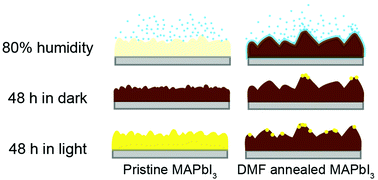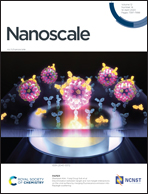Microscopic investigations on the surface-state dependent moisture stability of a hybrid perovskite†
Abstract
Hybrid organic–inorganic perovskite (HOIP) materials have caught significant attention in photovoltaics and photoelectronics for their outstanding photovoltaic properties. However, their instability to various environment, such as illumination, temperature, moisture and oxygen, hinders their way to commercialization. To figure out the interaction mechanism between H2O and CH3NH3PbI3 (MAPbI3), extensive theoretical studies have been carried out; however, the experimental results are insufficient and inconsistent. Here, we systematically investigate and compare the influence of H2O on MAPbI3 perovskite films with or without DMF) post-annealing in dark or light condition. The interaction between H2O and the surface of pristine MAPbI3 leads to the fusion of grain boundaries thus grain growth into micron level in short-time moisture exposure. While the penetration of H2O into MAPbI3 results in swelled crystalline whisker, cracking into smaller grains in long-time exposure upon the release of H2O. However, no degradation occurs in dark condition. As the DMF post-annealing treatment changes the surface states of MAPbI3, the interactions between the external H2O and internal MAPbI3 significantly varies from the pristine MAPbI3. Three different surface states with different topographies have influence on the interaction process and mechanism with H2O, leading to different decomposition rates, the striped surface that is the most rough among the three and experiencing the minimum change in surface potential with exposure to 80% humidity decomposes into PbI2 fastest. However, the addition of light will once again affect the aforementioned process. It is found that even ambient light could severely speed up the moisture-induced decomposition of MAPbI3, while the N,N-dimethylformamide (DMF) post-annealing treatment significantly improves the stability of MAPbI3 films upon exposure to humidity and illumination, benefiting from the MAI-deficient thus H2O resistant surface.



 Please wait while we load your content...
Please wait while we load your content...